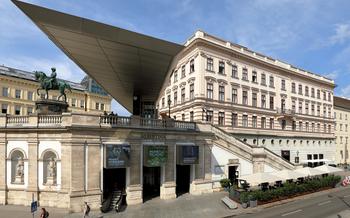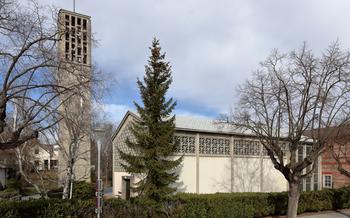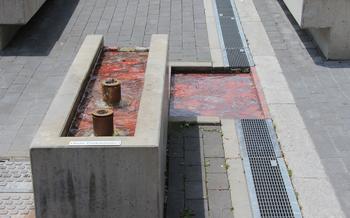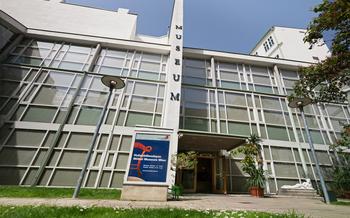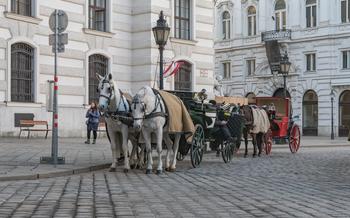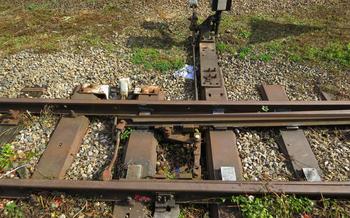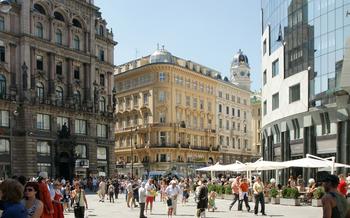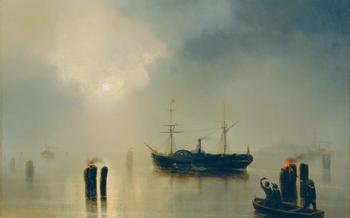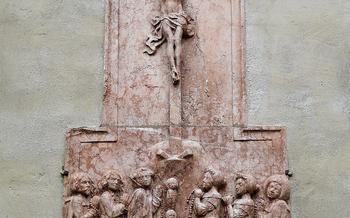
Albertina Museum and Art Gallery, Vienna
- Albertina Museum and Art Gallery:
- Highlights of the Albertina Collection
- Exploring the Old Masters
- Modern and Contemporary Art
- The Albertina's Print Room
- Temporary Exhibitions
- Architecture and History
- Planning Your Visit
- Location and Transportation
- Audio Guide and Guided Tours
- Museum Shop and Café
- Accessibility and Facilities
- Photography and Social Media
- Insider Tip: Embracing Tranquility
Albertina Museum and Art Gallery:
Nestled in the heart of Vienna, the Albertina Museum and Art Gallery stands as a testament to the rich artistic heritage of Austria. Founded in 1768 as a private collection by Duke Albert of Saxe-Teschen, husband of Archduchess Maria Christina of Austria, the Albertina has evolved into one of the world's foremost museums, housing a staggering collection of over one million prints and drawings, as well as a significant number of paintings and sculptures.
The Albertina's collection spans a vast array of artistic periods, from the Renaissance to the present day, and features works by some of the most renowned masters in the history of art, including Albrecht Dürer, Claude Monet, Vincent van Gogh, and Pablo Picasso. The museum's impressive holdings have been meticulously assembled over centuries through acquisitions, donations, and bequests, making it a treasure trove for art enthusiasts and scholars alike.
In addition to its permanent collection, the Albertina regularly hosts temporary exhibitions, showcasing works from its own collection as well as international loans. These exhibitions often focus on specific themes, artists, or movements, providing visitors with an opportunity to explore different aspects of the museum's diverse collection.
Highlights of the Albertina Collection
The Albertina Museum boasts an impressive collection of masterpieces from renowned artists across different eras. Among the highlights are Albrecht Dürer's "Hare," a meticulously detailed and symbolic representation of a wild rabbit. This iconic work showcases Dürer's mastery of observation and realism.
Claude Monet's "Water Lilies" offers a tranquil and ethereal glimpse into the artist's Giverny garden. With its soft brushstrokes and shimmering colors, this painting encapsulates the essence of Impressionism.
Vincent van Gogh's "Wheatfield with Crows" is a poignant and emotional landscape depicting a vast wheat field under a threatening sky. The vibrant colors and swirling brushwork convey the artist's inner turmoil and mental anguish.
Pablo Picasso's "The Weeping Woman" is a powerful and moving portrait of a woman in distress. With its distorted features and expressive brushstrokes, this painting exemplifies Picasso's unique style and his ability to convey raw emotions.
Exploring the Old Masters
The Albertina Museum boasts an impressive collection of Old Master paintings, representing the major artistic movements and schools from the Renaissance to the Baroque period. Among the highlights are:
- Italian Renaissance: Masterpieces by Raphael, such as his delicate "Madonna of the Goldfinch," and Titian, known for his vibrant colors and sensual figures, exemplified by his "Venus of Urbino."
- Dutch Golden Age: Explore the works of Rembrandt, the master of light and shadow, including his introspective self-portraits, and Vermeer, renowned for his serene and meticulously detailed domestic scenes.
- Flemish Baroque: Marvel at the vibrant and dynamic paintings by Rubens, known for his fleshy nudes and swirling compositions, and van Dyck, whose elegant portraits captured the essence of the Flemish aristocracy.
- German Renaissance and Baroque: Discover the intricate engravings and woodcuts of Albrecht Dürer, a master of the Northern Renaissance, and the expressive and colorful paintings of Lucas Cranach the Elder, a leading figure of the German Reformation.
Modern and Contemporary Art
The Albertina Museum and Art Gallery is a treasure trove of modern and contemporary art, boasting an impressive collection that spans over a century of artistic innovation and experimentation. Step into the world of Impressionism and Post-Impressionism, where masterpieces by Monet, Renoir, and Cézanne transport you to a realm of light, color, and atmosphere. Marvel at the bold brushstrokes and vibrant hues that define this groundbreaking movement.
Moving forward in time, encounter the revolutionary works of 20th-century masters such as Picasso, Matisse, and Kandinsky. Explore their unique perspectives and artistic styles, from Cubism's fragmented forms to Fauvism's intense colors and Expressionism's emotional intensity. These revolutionary artists challenged traditional conventions and paved the way for a new era in art.
Finally, delve into the realm of contemporary art, where works by Warhol, Baselitz, and Kiefer push boundaries and spark thought-provoking conversations. Witness the diverse expressions of our time, as artists grapple with societal issues, personal experiences, and the nature of art itself. The Albertina's collection offers a dynamic and ever-evolving journey through the world of modern and contemporary art, ensuring that there is something for every visitor to discover and appreciate.
The Albertina's Print Room
The Albertina's Print Room is a treasure trove for lovers of graphic art, housing a world-renowned collection of prints and drawings spanning various periods and artistic movements. Among the highlights are exquisite works by Leonardo da Vinci, Michelangelo, and Rembrandt, showcasing their mastery in capturing intricate details and expressing emotions through lines and shading. Special exhibitions dedicated to graphic art are regularly organized, delving into specific themes or showcasing the works of individual artists. These exhibitions offer a unique opportunity to explore the diverse range of techniques and styles within the realm of printmaking, from early woodcuts to contemporary lithographs.
Temporary Exhibitions
The Albertina Museum constantly refreshes its offerings with a dynamic program of temporary exhibitions. These exhibitions delve into specific themes, artistic movements, or individual artists, showcasing masterpieces from the Albertina's vast collection alongside works on loan from international institutions.
Temporary exhibitions at the Albertina are curated with the same rigor and expertise as the permanent collection, ensuring a consistently high quality of presentation. They provide an opportunity to explore new perspectives on art history, discover emerging artists, and engage with contemporary artistic practices.
Past temporary exhibitions have covered a wide range of topics, including the works of Caravaggio, Monet, Picasso, and Klimt, as well as thematic exhibitions on surrealism, photography, and fashion. The Albertina also collaborates with other museums and institutions around the world to bring major exhibitions to Vienna, such as the recent blockbuster exhibition on the Renaissance master Raphael.
Whether you are an art aficionado or simply looking for a new cultural experience, the Albertina's temporary exhibitions are sure to offer something of interest. Be sure to check the museum's website or social media channels for the latest exhibition schedule and updates.
Architecture and History
The Albertina Museum is housed in a magnificent Habsburg-era palace, a testament to the grandeur and opulence of the Austro-Hungarian Empire. Built in the 18th century, the palace was originally designed as a residential residence for Duke Albert of Saxe-Teschen, son-in-law of Empress Maria Theresa. The palace's striking Baroque architecture, with its intricate facade and opulent interiors, reflects the refined taste and artistic patronage of the Habsburgs.
Over the years, the palace underwent several transformations and expansions. In the 19th century, it was converted into a museum to house the growing collection of Archduke Albert and his wife, Archduchess Maria Christina. The museum opened its doors to the public in 1822, showcasing a vast array of artworks from the Habsburg collection.
The Albertina's evolution from a private collection to a public institution mirrors the changing cultural landscape of Austria. The museum's commitment to preserving and exhibiting its rich artistic heritage has made it a beloved destination for art enthusiasts worldwide. Visitors can not only admire the stunning artworks but also immerse themselves in the history and grandeur of the Habsburg dynasty.
Planning Your Visit
To make the most of your visit to the Albertina Museum and Art Gallery, careful planning is essential. Here are some helpful tips to ensure a smooth and enjoyable experience:
-
Purchase Tickets in Advance: Avoid long lines and secure your entry by purchasing tickets online or through reputable ticket vendors. This option allows you to choose a specific time slot, reducing wait times and ensuring a hassle-free visit.
-
Guided Tours and Audio Guides: Enhance your experience with a guided tour led by knowledgeable museum educators. These tours provide insider insights, historical context, and captivating stories behind the artworks. Alternatively, opt for an audio guide available in multiple languages, offering a self-paced tour at your convenience.
-
Consider Accessibility: The Albertina is committed to providing an inclusive environment for all visitors. Wheelchair users and visitors with disabilities can request assistance, utilize accessible entrances and elevators, and access adapted restrooms. The museum also offers sign language interpretation upon advance notice.
Location and Transportation
The Albertina Museum is conveniently situated in the heart of Vienna, within easy reach of other attractions, historical landmarks, and transportation hubs. To get there, you can take the U-Bahn (subway) and alight at the Karlsplatz station, which is just a short walk from the museum. Alternatively, several tram lines, including the 1, 2, and D, stop nearby, providing a scenic and convenient way to reach the Albertina. If you prefer to explore the city on foot, the Albertina is a pleasant 15-minute stroll from the Hofburg Palace and the State Opera. For those arriving by car, there are several parking garages in the vicinity, including the Kärntner Straße Garage and the Albertina Passage Garage, which offer convenient parking options.
Audio Guide and Guided Tours
Enhance your visit to the Albertina Museum with an audio guide or guided tour. The audio guides are available in multiple languages and offer insightful commentary on the museum's highlights, providing additional context and historical information.
Guided tours led by knowledgeable museum educators are also available. These tours offer a more in-depth exploration of the collection, with expert insights and anecdotes that bring the artworks to life. Whether you prefer the flexibility of an audio guide or the personalized experience of a guided tour, there is an option to suit every visitor's preference.
Immerse yourself in the Albertina's artistic treasures and gain a deeper understanding of the masterpieces that have shaped the course of art history.
Museum Shop and Café
The Albertina Museum also houses a well-curated museum shop where visitors can purchase a variety of souvenirs and art-related gifts. From high-quality reproductions of famous artworks to unique and locally crafted items, the shop offers something for every taste and budget. Visitors can find books, posters, postcards, jewelry, homeware, and even limited-edition prints inspired by the museum's collection.
After exploring the museum's galleries, visitors can take a break and relax at the on-site café. The café offers a range of refreshments, including coffee, tea, and pastries, as well as light meals and snacks. Visitors can enjoy their refreshments while taking in the artistic atmosphere of the museum. The café's outdoor seating area provides a delightful spot to soak in the vibrant energy of the city while contemplating the museum's masterpieces.
Accessibility and Facilities
The Albertina Museum is committed to providing a welcoming and accessible environment for all visitors. Wheelchair users and visitors with disabilities can enjoy a comfortable and inclusive visit thanks to the museum's thoughtful facilities and services.
Throughout the museum, wheelchair ramps and elevators ensure that all levels and galleries are accessible, allowing visitors to explore the collection without barriers. There are also designated accessible restrooms, baby changing rooms, and family-friendly amenities to cater to the needs of families with young children.
For those who require assistance, the Albertina offers a range of services, including wheelchair rentals and guided tours specifically designed for visitors with disabilities. The museum staff is also trained to provide assistance and ensure that everyone has an enjoyable and enriching experience.
To further enhance accessibility, the Albertina provides clear signage and wayfinding systems to help visitors navigate the museum's spaces easily. Braille labels and audio descriptions are available for selected artworks, enabling visually impaired visitors to engage with the collection in a meaningful way.
Overall, the Albertina Museum's commitment to accessibility ensures that all visitors, regardless of their abilities, can fully appreciate the wonders of art and culture within its walls.
Photography and Social Media
The Albertina Museum embraces the use of photography and social media as a means to share and connect with art enthusiasts worldwide. Visitors are encouraged to capture their favorite artworks and moments within the museum, adhering to the designated photography policies. However, the use of flash and tripods is prohibited to ensure the preservation and safety of the artworks.
By sharing your Albertina experience on social media using the official hashtags, you can join a vibrant community of art lovers and enthusiasts. The museum actively engages with its followers, sharing insights, behind-the-scenes glimpses, and exclusive content. Participating in online discussions and sharing your thoughts and impressions helps foster a sense of connection and appreciation for art among a global audience.
The Albertina's social media presence extends beyond showcasing its collection. It also serves as a platform for promoting educational initiatives, upcoming exhibitions, and events. By following the museum's social media channels, you can stay up-to-date on the latest news, participate in virtual tours and workshops, and engage with curators and experts in the field. Embrace the opportunity to share your Albertina experience and become part of a dynamic and passionate community of art enthusiasts.
Insider Tip: Embracing Tranquility
To fully immerse yourself in the Albertina's artistic treasures, consider planning your visit for a weekday morning. During this time, the museum tends to be less crowded, allowing you to wander through the galleries at a leisurely pace and truly appreciate the artworks without the hustle and bustle of large crowds. This tranquil atmosphere provides an intimate setting for contemplating the masterpieces and engaging with the museum's rich history. Embrace the serenity of a weekday morning at the Albertina and let the art speak to you in a profound and personal way.
